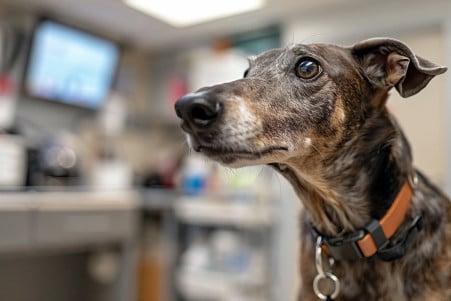Can Dogs Get Shingles? Viral Transmission and Skin Issues
16 May 2024 • Updated 15 May 2024

Although dogs can’t get the shingles virus, they can experience skin issues and nerve pain that are similar to the symptoms of shingles after being exposed to the virus that causes the condition in humans. The varicella-zoster virus that causes shingles and chickenpox in humans can cause a condition known as shingles-like virus in dogs, which is characterized by skin lesions that are covered in crusts and nerve pain in the spine or face.
To learn more about what this means for our furry friends and the factors that make them more or less likely to experience this shingles-related condition, we referenced veterinary experts sharing their insights on viral transmission and reactivation in dogs. Our investigation includes information on how the condition is diagnosed, treated and prevented, including how to avoid the spread of the varicella-zoster virus between dogs and humans.
Can dogs get shingles?
Canine Herpesvirus: Symptoms and Diagnosis
Canine herpesvirus (CHV) is most severe in puppies less than 3 weeks old, and can cause severe, often fatal symptoms according to PetMD and the Merck Veterinary Manual. These symptoms include lethargy, anorexia, respiratory distress (e.g., pneumonia), diarrhea, and even seizures. Meanwhile, older puppies and adult dogs typically have milder symptoms, including nasal discharge, coughing, sneezing, and genital lesions, according to VCA Animal Hospitals.
Pregnant dogs that are infected with CHV can experience complications, including abortions, stillbirths, and infertility, which is why the virus is considered a significant reproductive problem by PetMD. CHV is diagnosed based on clinical signs, antibody tests, or PCR testing of bodily fluids or tissues to detect the virus, and the elimination of other possible causes, according to Merck.
Because the prognosis for puppies with advanced CHV infection is generally very poor, especially if the puppies are less than 1 week old, according to VCA and Merck, early diagnosis is key. If symptoms are recognized early, supportive care can be more effective, but even with treatment, mortality rates are high in severe cases. This makes it especially important to be vigilant, especially with newborn litters and pregnant mothers, who are most at risk from this devastating viral infection.
How Canine Herpesvirus Is Spread and Risk Factors
CHV is highly infectious and can be spread through direct contact with infected secretions like nasal discharge, saliva, or genital fluids, according to the ScienceDirect Topics overview. Puppies can be infected during birth or in the days following birth by their infected mothers, according to the American Kennel Club. Airborne transmission and fomites (inanimate objects like bedding, food and water dishes, and toys) also contribute to the spread of the virus, says the AKC.
Risk factors for CHV infection include the conditions in a breeding kennel, the age of the dog (puppies less than 3 weeks old are most at risk), and the dog's immune status, according to The Native Antigen Company. Proper hygiene, isolation of infected dogs, and avoiding overcrowding are important preventive measures, especially for pregnant females and newborn litters, says the AKC. These measures can help prevent the rapid spread of this highly infectious virus in breeding facilities and homes.
How Canine Herpesvirus Is Prevented and Managed
Vaccination of breeding dogs, particularly females, can help ensure that puppies receive protective maternal antibodies during the critical neonatal period, according to a study published in PMC. In addition, strict hygiene measures, including the regular cleaning and disinfection of surfaces and equipment, are important in breeding facilities and kennels to help prevent the spread of CHV, as pointed out by Vets-Now.
In addition, isolating pregnant dogs and newborn litters and avoiding contact with other dogs can help reduce the risk of exposure, according to Vets-Now. It is also important to maintain the right environmental conditions, including keeping puppies warm, to help reduce the risk of CHV infection, since the virus is most active in temperatures below 95°F (35°C) according to the Mar Vista Animal Medical Center.
While there is no cure for CHV, early treatment with supportive care, including fluids, antibiotics, and antiviral drugs, can help improve the chances of survival in puppies that have been infected, although the outlook is generally poor, according to Mar Vista. Although these interventions can help control CHV outbreaks, it's still important to be vigilant and take preventive measures to protect at-risk dogs.
How Common Is Canine Herpesvirus Infection and What Are the Risk Factors?
Canine herpesvirus is a highly prevalent viral infection in dogs around the world, with prevalence rates of 30% to 90% in various regions and kennels, according to a study in Animals. Dogs that are infected with the virus can be asymptomatic carriers, which has helped the virus become widely distributed, according to ScienceDirect Topics.
Risk factors for infection and disease include conditions in the breeding kennel, age (puppies and younger dogs are more at risk), and immune status, according to PubMed. Prepubescent bitches and dogs under 1.5 years old have been found to have lower seroprevalence rates, which may indicate age-related resistance or exposure patterns, according to the Cornell University College of Veterinary Medicine.
Although CHV is generally considered species-specific, there is some evidence of limited cross-species transmission, especially to other canids such as coyotes and wolves, according to ScienceDirect Topics. This information is important for developing prevention and management plans that can help protect at-risk dog populations.
Long-term Effects and Impact on Dogs
Puppies that survive the initial CHV infection can shed the virus in nasal, ocular, and fecal secretions for an extended period, which may lead to the potential spread of the virus to other dogs, according to a study published in PMC. Adult dogs that have recovered from CHV infection can also experience reactivation and shedding of the virus, especially when they are stressed or have weakened immune systems, says the Merck Veterinary Manual.
Latent CHV infection in breeding dogs can also cause reproductive problems, such as infertility, abortions, and neonatal deaths in future litters, according to the Merck Veterinary Manual. To help prevent these long-term effects, the Merck Veterinary Manual stresses that it is important to manage and monitor dogs that have recovered from CHV, including isolating them when they are shedding the virus and using responsible breeding practices.
More research is necessary to fully understand the pathobiology, transmission dynamics, and long-term consequences of canine herpesvirus infection, according to the PMC study. To help address the many challenges of this persistent viral infection in dog populations, it will be important to stay watchful and use proactive management techniques.
Conclusion: Responsible Dog Ownership and Canine Herpesvirus
Canine herpesvirus is a potentially deadly viral infection that can cause serious health problems, especially in puppies and breeding dogs. It is important for dog owners and breeders to be aware of the symptoms, how the virus is transmitted, and the risk factors associated with CHV.
By doing so, dog owners and breeders can take steps to prevent the spread of the virus. This includes vaccination, maintaining good hygiene, and isolating infected dogs. While early detection and supportive care can help puppies infected with CHV, the outlook for severe cases is still poor.
More research and monitoring is needed to fully understand and address the long-term consequences and risks associated with canine herpesvirus in dogs around the world.


